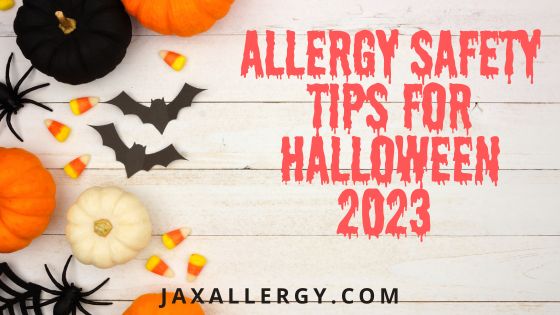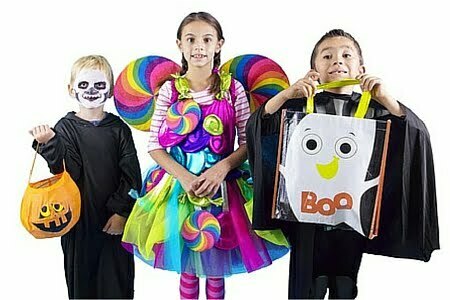Our Top Tips for Allergy Safety this Halloween

With pumpkins everywhere and stores filled with Spiderman, Barbie, and Wednesday Addams costumes that can mean only one thing: it’s almost time for what may be kids’ favorite holiday – HALLOWEEN!
Their excitement, however, is tempered by parents’ caution about their children’s safety. For parents of a child with allergies, the concerns are even greater.
The good news is that there is a lot you can to do ensure your kids have a safe, fun Halloween. Here are four tips that can help:
Help Make Your Child’s School Party Safe
Many schools and daycare facilities host Halloween parties, which can be especially stressful for parents since you’re not there to protect your children. In addition, younger children don’t have the awareness to say no to certain types of candy or give in to the temptation to have the same foods their friends are enjoying.
The keys to a stress- and allergy-free class party includes partnering with the teacher, class parent or other school staff member. If you’re unable to volunteer to help or be present on party day, find out who the party host will be and coordinate with him or her in advance about your child’s allergy and any action plan that may be needed to respond to an allergy emergency.
If you can be involved in the party planning, you can encourage a focus on non-food related activities, such as crafts, little toy bags, a scavenger hunt, or Halloween games.
Food will likely be part of the festivities however, so discuss options that would be safe for your child and that can still be enjoyed by everyone. A great way to ensure your child isn’t being left out is to offer to provide his or her treats or find out if there is an allergy-free version of the treat your child will be able to have.
If you are sending your child with their own safe food, ensure the teacher or monitor knows this is the only food that you child can eat at the party.
Know Ahead of Time What Candies are Safe for Your Child
Deciding to allow your child to trick-or-treat should depend on how severe his or her allergies are. If you decide it’s safe enough to go door to door, always have a safety plan in place and have precautions ready.
Let your child know before you even leave the house that he or she is not to eat any food until you’ve gotten home and had the chance to check all their candy. Setting the expectation before you head out is crucial for kids of all ages. Older children probably already have a good understanding of why this is necessary, but with a simple and appropriate explanation of the dangers, younger kids can be made to understand why they’ll need to contain their excitement about sampling treats while they’re out.
Before Halloween arrives, consider alerting your neighbors to your child’s allergy. Ask them to not offer any foods to which your child is allergic and suggest they offer a toy, a little money or other non-food item. (You could even provide your neighbors with such items yourself.) Asking in advance allows your neighbors to be prepared.
Once trick or treating is done, sort through the treats and find the safe ones and put them back into your child’s bag – then create a pile of definite no’s. You may have a third pile of “unsure” treats. You may need to do some research to determine if they are safe for your child, or if you feel it’s not worth the risk, simply remove them. Often, mini-bagged treats will have warnings on whether they were produced in facility that processes nuts or other allergens.
Do not leave your child alone with his or her candy. Temptations can be too strong, and you may find your child digging in at the first opportunity.
We’ve found that certain normally safe candies may be produced in different plants for the holiday version of the candy, and this may make them unsafe. This is why it’s so important to read labels on all potentially dangerous candies.
If throwing out a lot of candy seems wasteful to you, one fun tradition we’ve heard of is to place all the unsafe candy in your young child’s trick-or-treat bag and place it on the porch overnight. They will get a visit from the “Great Pumpkin” who will exchange their unsafe candy for something they can enjoy.
If your child suffers from severe allergies and trick-or-treating is just too dangerous, planning a fun party with some of their friends and having Halloween shows and crafts is a great option. Although candy is most associated with the holiday, it doesn’t have to be the most important thing. Kids will have just as much fun dressed up and playing as they do knocking on doors.
Always Have Your Safety Supplies on Hand
You already know this, but we’ll say it again: You must always have your safety supplies ready whether your child is walking your neighborhood, at a school party, or at a friend’s house. If your child is prone to an anaphylactic shock always have an epinephrine auto-injector and other medications that your allergist has provided. If your child’s allergies are less severe, have sanitizing wipes available for contact allergies and any medications you give for minor allergic reactions.
Understand the Signs of Anaphylaxis
An anaphylactic reaction can come on suddenly, and young children may not know what is happening to them so be aware of warning sings. A child might start to complain of:
- Feeling like they have a lump in the throat (or they start sounding hoarse)
- Seem to have trouble breathing or begin wheezing. May also start to complain of chest tightness
- Say they have a tingling feeling in the hands, feet, lips or scalp
- Begin to flush and get red around the neck or face
Other symptoms of anaphylaxis are dizziness and confusion.
If you, your child, or another child around you begin to experience any of the above symptoms, use an autoinjector (if you have one) and call 911 immediately.
You should also discuss with your child what to do if he or she starts feeling itchy, having trouble breathing or showing any signs of a reaction. Talk with your child in advance about what happens when an allergic reaction occurs and what treatment measures you may have to take. The more they are involved in their treatment, the more in control they will feel.
Candy Is Not the Only Issue – Don’t Forget Costumes
If your child has contact allergies or suffers from hives or other skin issues, be aware of costumes and face and skin paint accessories that could lead to reactions. Most kids costumes are safe and hypo-allergenic, but some of the accessories may set off a reaction. Look out for nickel in some costume accessories such as cowboy belts, swords, tiaras and magic wands. Nickel is one of the most common causes of allergic contact dermatitis, which can make skin itch and ruin an otherwise fun night of trick-or-treating.
Be on the lookout for ingredients in cheap Halloween makeup, which may cause allergic reactions. If your child must use makeup, opt for the higher-quality products. Don’t assume, however, that because it’s more expensive it’s safe – always test makeup ahead of time by applying a little bit to a small area of skin a few days in advance to check for a reaction.
Look for the Teal Pumpkins
The Teal Pumpkin Project is a FARE campaign to help make Halloween safer for kids with allergies.
Launched in 2014 the Teal Pumpkin Project aims to increase awareness of food allergies as well as promote inclusion for all of our trick-or-treaters. There are some great resources to show your support and even to add your house to a crowd sourced map of a list of homes that are participating-most Teal Pumpkin participants are offering treats other than candies.
Do some pre-Halloween planning and keep a few tricks handy, and you and your goblins can be sure to have a safe and awesome Halloween!
If you are worried that you or your child might have allergies or asthma – contact Allergy and Asthma Specialists of North Florida to schedule an appointment or to talk with one of our Board Certified Allergists.
For more great allergy safety information visit our friends at FoodAllergy.org


